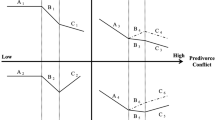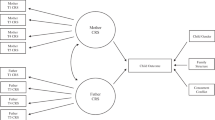Abstract
Interparental conflict (IPC) has the potential to adversely affect children’s social, emotional, and behavioural functioning. The overall objective of this study was to investigate the relationship between both the severity and chronicity of IPC across early and middle childhood and children’s emotional–behavioural functioning at 10–11 years. Specifically, we aimed to: (1) identify distinct trajectories of IPC spanning 10–11 years since birth of the study child as reported by mothers, and (2) examine the emotional–behavioural functioning of children exposed to the identified IPC trajectories. Drawing from a nationally representative longitudinal study of Australian families (N = 4875), four distinct trajectories of IPC were identified: (1) consistently low exposure to IPC over time, (2) persistently elevated exposure to IPC, (3) increasing IPC exposure over time, and (4) decreasing IPC exposure over time. Children exposed to trajectories with high IPC at any point during the study period were reported by their mothers to be experiencing more emotional–behavioural difficulties than children exposed to low IPC over time. Based on teacher report, there were no differences in emotional–behavioural functioning of children exposed to the different patterns of IPC. Our findings reinforce that high parental conflict at any point in a child’s life is a form of adversity that can have adverse consequences for their mental health, and that early interventions for parents and caregivers experiencing high IPC are critical.

Similar content being viewed by others
References
Brock R, Kochanska G (2016) Interparental conflict, children’s security with parents, and long-term risk of internalizing problems: a longitudinal study from ages 2 to 10. Dev Psychopathol 28:45–54
Davies PT, Hentges RF, Coe JL, Martin MJ, Sturge-Apple ML, Cummings EM (2016) The multiple faces of interparental conflict: implications for cascades of children’s insecurity and externalizing problems. J Abnorm Psychol 125:664–678
Harold G, Aitken J, Shelton K (2007) Inter-parental conflict and children’s academic attainment: a longitudinal analysis. J Child Psychol Psychiatry 48:1223–1232
Rhoades K (2008) Children’s responses to interparental conflict: a meta-analysis of their associations with child adjustment. Child Dev 79:1942–1956
Shelton K, Harold G (2008) Interparental conflict, negative parenting, and children’s adjustment: Bridging links between parents’ depression and children’s psychological distress. J Fam Psychol 22(5):712–724
Schiff M, Plotnikova M, Dingle K, Williams G, Najman J, Clavarino A (2014) Does adolescent’s exposure to parental intimate partner conflict and violence predict psychological distress and substance use in young adulthood? A longitudinal study. Child Abuse Negl 38:1945–1954
Westrupp E, Rose N, Nicholson J, Brown S (2015) Exposure to inter-parental conflict across 10 years of childhood: data from the longitudinal study of Australian children. Matern Child Health J 19:1966–1973
Yelland J, Sutherland G, Brown S (2010) Postpartum anxiety, depression and social health findings from a population-based survey of Australian women. BMC Public Health 10:771–782
Liu C, Tronick E (2013) Re-conceptualising prenatal life stressors in predicting post-partum depression: Cumulative-, specific-, and domain-specific approaches to calculating risk. Paediatr Perinat Epidemiol 27:481–490
van Eldik WM, de Haan AD, Parry LQ, Davies PT, Luijk MPCM, Arends LR, Prinzie P (2020) The interparental relationship: meta-analytic associations with children’s maladjustment and responses to interparental conflict. Psychol Bull 146:553–594
Kouros C, Cummings EM, Davies PT (2010) Early trajectories of interparental conflict and externalizing problems as predictors of social competence in preadolescence. Dev Psychopathol 22:527–537
El-Sheikh M, Cummings EM, Kouros C, Elmore-Staton L, Buckhalt J (2008) Marital psychological and physical aggression and children’s mental and physical health: direct, mediated, and moderated effects. J Consult Clin Psychol 76:138–148
Troxel WM, Matthews KA (2004) What are the costs of marital conflict and dissolution to children’s physical health? Clin Child Fam Psychol Rev 7:29–57
Westrupp EM, Brown S, Woolhouse H, Gartland D, Nicholson JM (2018) Repeated early-life exposure to inter-parental conflict increases risk of preadolescent mental health problems. Eur J Pediatr 177:419–427
Davies P, Cummings E (1994) Marital conflict and child adjustment: an emotional security hypothesis. Psychol Bull 116:387–411
Grych J, Fincham F (1990) Marital conflict and children’s adjustment: a cognitive-contextual framework. Psychol Bull 108:267–290
Cummings E, Davies P, Simpson K (1994) Marital conflict, gender, and children’s appraisals and coping efficacy as mediators of child adjustment. J Fam Psychol 8:141–149
Shonkoff J (2010) Building a new biodevelopmental framework to guide the future of early childhood policy. Child Dev 81:357–367
Hanington L, Heron J, Stein A, Ramchandani P (2012) Parental depression and child outcomes—is marital conflict the missing link? . Child Care Health Dev 38:520–529
Kurdek LA (1999) The nature and predictors of the trajectory of change in marital quality for husbands and wives over the first 10 years of marriage. Dev Psychol 35:1283–1296
Mitnick DM, Heyman RE, Smith Slep AM (2009) Changes in relationship satisfaction across the transition to parenthood: a meta-analysis. J Fam Psychol 23:848–852
Goeke-Morey MC, Papp LM, Cummings EM (2013) Changes in marital conflict and youths’ responses across childhood and adolescence: a test of sensitization. Dev Psychopathol 25:241–251
Giallo R, Rose N, Cooklin A, McCormack D (2013) In survival mode: Mothers’ and fathers’ expereinces of fatigue in the early parenting period. J Reprod Infant Psychol 31:31–45
Sturge-Apple M, Davies P, Cummings E (2006) Impact of hostility and withdrawal in interparental conflict on parental emotional unavailability and children’s adjustment difficulties. Child Dev 77:1623–1641
Fraley RC, Roisman GI, Haltigan JD (2013) The legacy of early experiences in development: Formalizing alternative models of how early experiences are carried forward over time. Dev Psychol 49:109–126
Soloff C, Lawrence D, Johnstone R (2005) Sample design (LSAC Technical Paper, No. 1). Australain Institute of Family Studies, Commonwealth of Australia, Melbourne.
Mission S, Sipthorp M (2007) LSAC Technical paper No. 5: Wave 2 weighting and non-response. Australian Institute of Family Studies, Melbourne.
Australian Institute of Family Studies (2005) Growing up in Australia: The longitudinal study of Australian children: 2004 Annual Report. Australian Department of Family and Community Services, Melbourne
Goodman R (2001) Psychometric properties of the strengths and difficulties questionnaire. J Am Acad Child Adolesc Psychiatry 40:1337–1345
Bayer J, Ukoumunne O, Lucas N, Wake M, Scalzo K, Nicholson J (2011) Risk factors for childhood mental health symptoms: national longitudinal study of Australian children. Pediatrics 128:865–879
Blakemore T, Strazdins L, Gibbings J (2009) Measuring family socioeconomic position. Aust Social Policy 8:121–168
Muthen L, Muthen B (1998–2011) Mplus User's Guide. Muthen & Muthen, Los Angeles
Davies PT, Myers R, Cummings EM, Heindel S (1999) Adult conflict history and children’s subsequent responses to conflict: an experimental test. J Fam Psychol 13:610–628
Cummings E, Davies P (1994) Maternal depression and child development. J Child Psychol Psychiatry 35:73–112
Krishnakumar A, Buehler C (2000) Interparental conflict and parenting behaviors: a meta-analytic review. Fam Relat 49:25–44
Low S, Stocker C (2005) Family functioning and children’s adjustment: associations among parents’ depressed mood, marital hostility, parent-child hostility, and children’s adjustment. J Fam Psychol 19(3):394–403
Davies PT, Sturge-Apple M, Cicchetti D, Manning L, Zale E (2009) Children’s patterns of emotional reactivity to conflict as explanatory mechanisms in links between interpartner aggression and child physiological functioning. J Child Psychol Psychiatry 50:1384–1391
Pendry P, Adam E (2007) Associations between parents’ marital functioning, maternal parenting quality, maternal emotion and child cortisol levels. Int J Behav Dev 31:218–231
Repetti R, Taylor S, Seeman T (2002) Risky families: family social environments and the mental and physical health of offspring. Psychol Bull 128:330–366
Johnson S, Hollis C, Marlow N, Simms V, Wolke D (2014) Screening for childhood mental health disorders using the Strengths and Difficulties Questionnaire: the validity of multi-informant reports. Dev Med Child Neurol 56:453–459
van Dijk R, van der Valk IE, Deković M, Branje S (2020) A meta-analysis on interparental conflict, parenting, and child adjustment in divorced families: examining mediation using meta-analytic structural equation models. Clin Psychol Rev 79:101861
Acknowledgements
This paper uses unit record data from Growing Up inAustralia, the Longitudinal Study of Australian Children. The study is conducted in partnership between the Australian Government Department of Social Services (DSS), the Australian Institute of Family Studies (AIFS), and the Australian Bureau of Statistics (ABS).The findings and views reported are those of the authors and should not be attributed to DSS, AIFS, or ABS. All MCRI staff were supported by the Victorian Government’s Operational Infrastructure Program, and the NHMRC Safer Families Centre of Research Excellence. RG and SB were supported by an NHMRC Career Development Fellowship and an NHMRC Research Fellowship, respectively. DC was supported by the Australian Research Council Centre of Excellence for Children and Families over the Life Course (CE140100027).
Author information
Authors and Affiliations
Corresponding author
Ethics declarations
Conflict of interest
On behalf of all authors, the corresponding author states that there is no conflict of interest.
Rights and permissions
About this article
Cite this article
Giallo, R., Seymour, M., Fogarty, A. et al. Trajectories of interparental conflict and children’s emotional–behavioural functioning at 10–11 years: an Australian population-based study. Eur Child Adolesc Psychiatry 31, 625–635 (2022). https://doi.org/10.1007/s00787-020-01700-7
Received:
Accepted:
Published:
Issue Date:
DOI: https://doi.org/10.1007/s00787-020-01700-7




